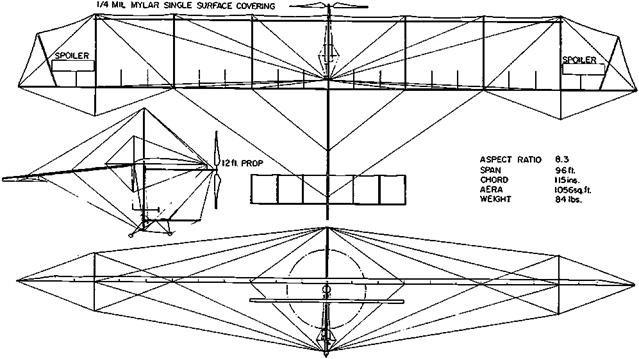The Gossamer and MIT Human-Powered Aircraft
A general arrangement drawing of the original Gossamer Condor human powered airplane is shown in Figure 13.2. All of the Gossamer aircraft are canards because of the packaging convenience of the pilot-powerplant combination with its plastic chain-driven pusher propeller. Like the Wright brothers before them, the team found it relatively easy to control pitch attitude (and angle of attack) even though the center of gravity was behind the neutral point. An opposite wing warp and tilted canard method of roll control developed for the Gossamer Condor (Sec. 5) was applied as well to the Gossamer Albatross. Finally, the Gossamer team pioneered in the art of using carbon fiber plastic tubes as bending and compression members in the airframe structure, thereby ensuring a very light weight (Grosser, 1981).
The MIT human-powered Chrysalis biplane and Monarch and Daedalus monoplanes were less radical in design than the Gossamer series, with tractor propellers and aft tails. All-moving tail surfaces and warping wings for lateral control were used at first. The Daedalus machine dispensed with wing warping or ailerons, relying on rudder control and dihedral effect. This proved insufficient.
|
Figure 13.2 Initial version of the Gossamer Condor human-powered ultralight airplane, with single-surface wings and spoilers for lateral control. The airplane could not be turned with the spoilers. (From Burke, “The Gossamer Condor and Albatross,” AIAA Professional Study Series, 1980) |












